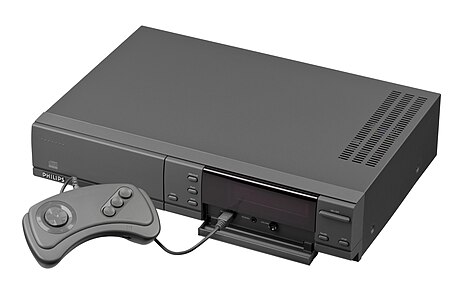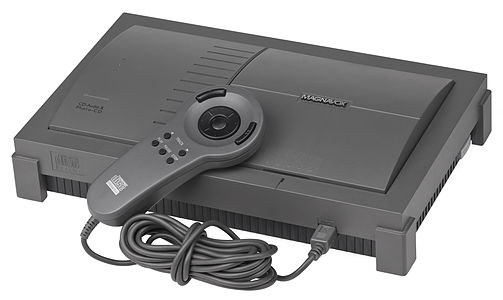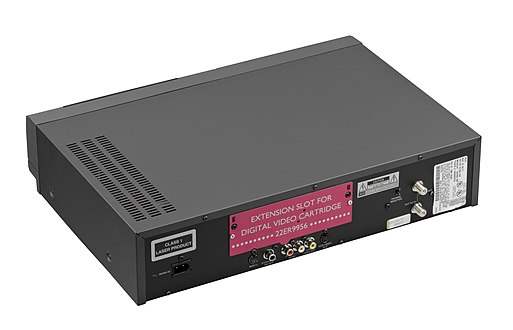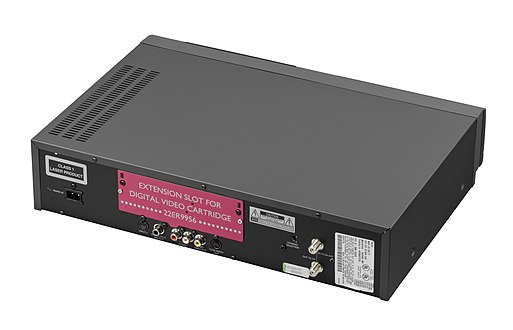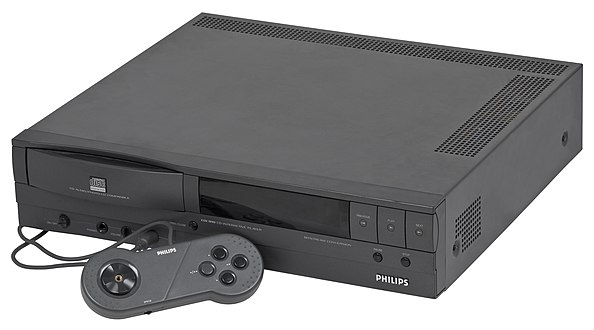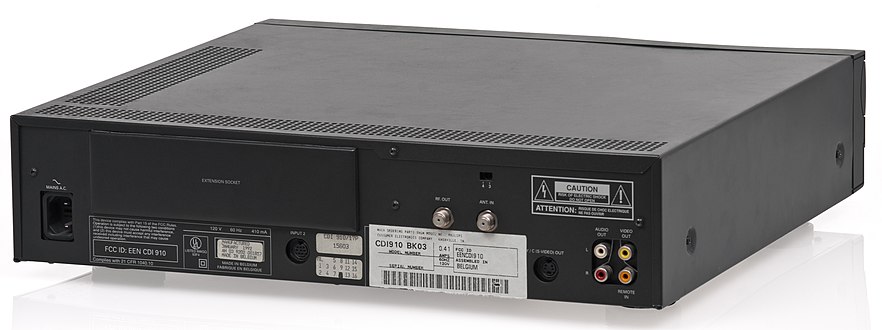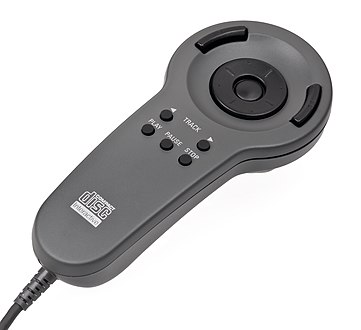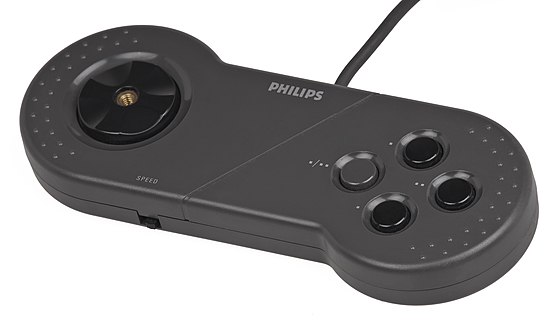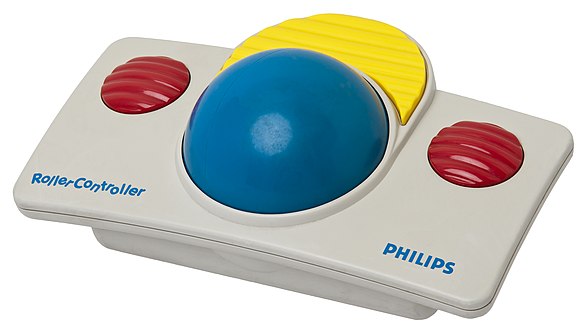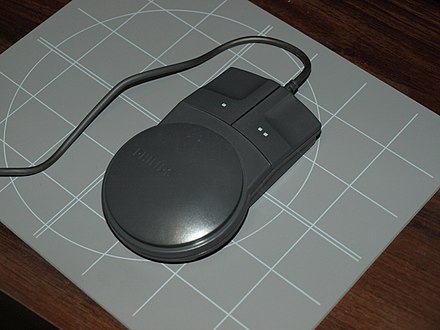History of video games/Platforms/CD-i
-
A Philips CD-i 220 with a controller attached.
-
A Phillips CD-i 400 with a controller attached.
History
[edit | edit source]Pre-launch
[edit | edit source]As early as December 1987 the CD-i and the ambitious concept behind it was highly anticipated by some media outlets.[2]
Launch
[edit | edit source]The CD-i was launched in 1991.[3] The platform was not marketed well early on, though a 1991 partnership with Nintendo on developing a CD-based add-on for the Super Nintendo gave Phillips the right to produce several games based on existing Nintendo game series.[4]
From October 25th, 1995 to sometime around 2000, the CD-i could access an online service known as CD-Online.[4][5]
Legacy
[edit | edit source]System
[edit | edit source]Phillips stopped active development of the CD-i in 1996 and the system was discontinued in 1998, with between 570,000 and one million CD-i consoles sold worldwide.[3][4][6]
Games
[edit | edit source]
| “ | I don't know that those really fit in the Zelda franchise. | ” |
—Eiji Aonuma - 2013, MTV Interview regarding the Hyrule Historia.[7] | ||
Mention of the CD-i Zelda games would often be omitted from official Nintendo retrospectives.[8]
Technology
[edit | edit source]Computation
[edit | edit source]The CD-i was powered by a Motorola 68000 processor clocked at 15.5 MHz.[9][10] This was a very common processor for this generation of consoles.
The CD-i had one megabyte of RAM.[10] A digital video add-on cartridge added an additional 1.5 megabytes of RAM, as well as allowing the CD-i to decode MPEG-1 video.[4] Finally the CD-i had eight kilobytes of persistent storage based on RAM, powered by a lithium battery, which is prone to failure from age.[4]
At the time of release, the CD-i was seen as a low performance system with a design that was relatively easy to develop for.[9]
Hardware
[edit | edit source]The CD-i could read CD-ROM Green Book disks at 170 kilobits per second.[4]
The CD-i runs a custom version of Microware OS9, a real-time operating system called CD-RTOS.[9][11] The CD-i supported the CD-Online service, which required the use of an adapter cable, software disk, and a 14.4K dial-up modem.[5]
Notable games
[edit | edit source]1993
[edit | edit source]Zelda: The Wand of Gamelon
[edit | edit source]An early counterpart game to Link: The Faces of Evil with a female protagonist, departing from Zelda-series norms to feature the titular Princess Zelda as the protagonist.
Read more about Zelda: The Wand of Gamelon on Wikipedia.
Link: The Faces of Evil
[edit | edit source]A counterpart game to Zelda: The Wand of Gamelon.
The game attracted widespread internet notoriety again in early 2021, when an artist redrew the character Morshu using hyper realistic 3D Graphic techniques.[12][13][14]
Read more about Link: The Faces of Evil on Wikipedia.
1994
[edit | edit source]Zelda's Adventure
[edit | edit source]The lesser known of the three Zelda games for the CD-i, it features live action cutscenes, perhaps the only Zelda-series game to do so. It also featured the titular princess as the protagonist, another departure from the typical Zelda-series formula at the time.
Read more about Zelda's Adventure on Wikipedia.
Hotel Mario
[edit | edit source]Read more about Hotel Mario on Wikipedia.
1996
[edit | edit source]RAM Raid
[edit | edit source]A notable early online FPS.
1997
[edit | edit source]Brain Dead 13
[edit | edit source]Read more about Brain Dead 13 on Wikipedia.
Burger King CD-i
[edit | edit source]Early game-based training software.
2022
[edit | edit source]Nobelia
[edit | edit source]Commercial homebrew game and platform exclusive released long after the CD-i was discontinued from the market.[15]
Cancelled
[edit | edit source]Super Mario's Wacky Worlds
[edit | edit source]A planned sequel to the SNES game Super Mario World.[16] An incomplete version of the game eventually surfaced.[17]
Read more about Super Mario's Wacky Worlds on Wikipedia.
Mario Takes America
[edit | edit source]Another canceled Mario game for the CD-i, with this title using a combination of real life photography and filming and overlaid 2D artwork.[18]
Gallery
[edit | edit source]Consoles
[edit | edit source]-
CDi 220 from the front right.
-
CDi 220 from the back left.
-
CDi 220 from the back right.
-
CDI 910 front with controller attached. The controller has its direction stick unscrewed.
-
CDI 910 rear showing IO and expansion socket. This console was made in Belgium.
Controllers
[edit | edit source]-
Paddle Controller
-
Gamepad
-
Roller Controller
-
The CDi Mouse
Remote controls
[edit | edit source]References
[edit | edit source]- ↑ "Philips CD-i 490 - Game Console - Computing History". www.computinghistory.org.uk. Retrieved 2020-12-12.
- ↑ "Vers un nouveau support : le CD-I Les charmes discrets de l'interactivité" (in fr). Le Monde. 1987-12-17. https://www.lemonde.fr/archives/article/1987/12/17/vers-un-nouveau-support-le-cd-i-les-charmes-discrets-de-l-interactivite_4079184_1819218.html.
- ↑ a b Damien, McFerran (2017-03-09). "6 games console flops that gave gaming a bad name" (in en). TechRadar. https://www.techradar.com/news/6-games-console-flops-that-gave-gaming-a-bad-name. Retrieved 2020-10-25.
- ↑ a b c d e f "Hardware Classics: Uncovering The Tragic Tale Of The Philips CD-i". Nintendo Life. 2018-07-23. Retrieved 2020-11-17.
- ↑ a b "Philips CD-Online - The Service Time Forgot (guest article by RetroDetect about the timeline of CD-i's Internet Kit and the CD-Online service)". Retrieved 2020-11-17.
- ↑ "The 10 Worst-Selling Consoles of All Time (page 2 of 2)". GamePro.com. 2007-11-03. Archived from the original on 2007-11-03. Retrieved 2020-11-17.
- ↑ a b "Eiji Aonuma Addresses Those Horrible ‘Zelda’ CD-i Games". web.archive.org. 3 December 2013. https://web.archive.org/web/20131203072003/http://multiplayerblog.mtv.com/2013/09/19/eiji-aonuma-addresses-those-horrible-zelda-cd-i-games/.
- ↑ McFerran, Damien (20 September 2013). "Surprise! Aonuma Doesn't Consider The CD-i Zelda Games To Be Canon, Either". Nintendo Life. https://www.nintendolife.com/news/2013/09/surprise_aonuma_doesnt_consider_the_cd_i_zelda_games_to_be_canon_either.
- ↑ a b c "Philips CD-i". Retro Gamer. Retrieved 2020-11-17.
- ↑ a b "Video Game Console Library CDi". Video Game Console Library. Retrieved 2020-11-18.
- ↑ "First Steps in OS-9 on Philips CDI605T". Retrostuff. 2019-07-21. Retrieved 2020-11-17.
- ↑ "Random: Morshu From Link: The Faces of Evil Has Been Turned Into A 3D Animation". Nintendo Life. 2021-01-24. https://www.nintendolife.com/news/2021/01/random_morshu_from_link_the_faces_of_evil_has_been_turned_into_a_3d_animation.
- ↑ "Forgotten Zelda NPC Is Horrifying In Full 3D". ScreenRant. 2021-01-26. https://screenrant.com/forgotten-zelda-npc-full-3d-cdi-horrifying/.
- ↑ "Zelda Fan Creates 3D Render of Morshu From Link: The Faces of Evil". Game Rant. 2021-01-25. https://gamerant.com/zelda-fan-creates-3d-render-morshu-link-faces-of-evil/.
- ↑ Whitehead, Thomas (16 March 2022). "Random: 'Zelda Meets Bomberman' In Nobelia, A New Philips CD-i Game". Nintendo Life. https://www.nintendolife.com/news/2022/03/random-zelda-meets-bomberman-in-nobelia-a-new-philips-cd-i-game.
- ↑ Zell-Breier, Sam (2021-01-07). "The Embarrassing Mario Games That Ended Up On Philips CD-I". Looper.com. https://www.looper.com/308532/the-embarrassing-mario-games-that-ended-up-on-philips-cd-i/.
- ↑ "Some Mario Games Just Can't Be Played Properly Anymore". Nintendo Life. 2018-05-19. https://www.nintendolife.com/news/2018/05/feature_some_mario_games_just_cant_be_played_properly_anymore.
- ↑ "The Cancelled Mario Game that was Taken Away by a Bank in Canada". Unseen64: Beta, Cancelled & Unseen Videogames!. 15 September 2014. https://www.unseen64.net/2014/09/15/mario-takes-america-cdi-cancelled/.
| Parts of this page are based on materials from: Wikipedia: the free encyclopedia. |
